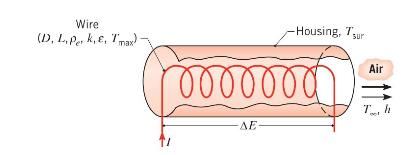An air heater may be fabricated by coiling Nichrome wire and passing air in cross flow over
Question:
An air heater may be fabricated by coiling Nichrome wire and passing air in cross flow over the wire. Consider a heater fabricated from wire of diameter \(D=\) \(2 \mathrm{~mm}\), electrical resistivity \(ho_{e}=10^{-6} \Omega \cdot \mathrm{m}\), thermal conductivity \(k=25 \mathrm{~W} / \mathrm{m} \cdot \mathrm{K}\), and emissivity \(\varepsilon=0.20\). The heater is designed to deliver air at a temperature of \(T_{\infty}=60^{\circ} \mathrm{C}\) under flow conditions that provide a convection coefficient of \(h=250 \mathrm{~W} / \mathrm{m}^{2} \cdot \mathrm{K}\) for the wire. The temperature of the housing that encloses the wire and through which the air flows is \(T_{\text {sur }}=60^{\circ} \mathrm{C}\).
 If the maximum allowable temperature of the wire is \(T_{\text {max }}=1000^{\circ} \mathrm{C}\), what is the maximum allowable electric current \(I\) ? If the maximum available voltage is \(\Delta E=110 \mathrm{~V}\), what is the corresponding length \(L\) of wire that may be used in the heater and the power rating of the heater? Hint: In your solution, assume negligible temperature variations within the wire, but after obtaining the desired results, assess the validity of this assumption.
If the maximum allowable temperature of the wire is \(T_{\text {max }}=1000^{\circ} \mathrm{C}\), what is the maximum allowable electric current \(I\) ? If the maximum available voltage is \(\Delta E=110 \mathrm{~V}\), what is the corresponding length \(L\) of wire that may be used in the heater and the power rating of the heater? Hint: In your solution, assume negligible temperature variations within the wire, but after obtaining the desired results, assess the validity of this assumption.
Step by Step Answer:

Fundamentals Of Heat And Mass Transfer
ISBN: 9781119220442
8th Edition
Authors: Theodore L. Bergman, Adrienne S. Lavine





